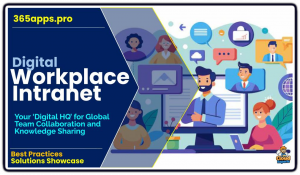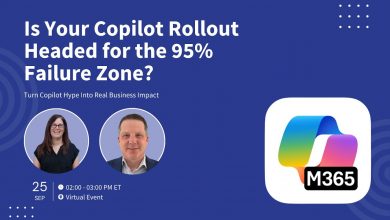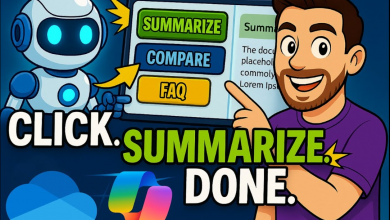Gamify SharePoint for Maximum Engagement & Adoption
This approach fosters a culture of participation and innovation, aligning platform usage with organizational goals.
 Gamifying SharePoint offers a powerful way to transform a potentially dry platform into an engaging, motivating environment that drives user adoption and productivity.
Gamifying SharePoint offers a powerful way to transform a potentially dry platform into an engaging, motivating environment that drives user adoption and productivity.
Many organizations struggle with low engagement on SharePoint due to its complex interface or lack of intuitive appeal, leading to underutilized features and missed opportunities for collaboration.
In the feature video, Dan from Academy 365 takes you behind the scenes of The Great Escape — his SharePoint-based escape room experience that won Best SharePoint Hack at the Microsoft 2025 Hackathon.
Gamification
By incorporating game design elements like points, badges, and challenges, gamification taps into human motivations such as achievement, recognition, and friendly competition, making routine tasks like document management or team collaboration more enjoyable.
This approach not only encourages employees to actively use SharePoint but also fosters a culture of participation and innovation, aligning platform usage with organizational goals.
To begin effectively gamifying SharePoint, understanding the audience and objectives is essential. By analyzing the workforce—whether knowledge workers, field staff, or managers—organizations can tailor gamification to their specific needs, such as document management or team collaboration.
Clear goals, like increasing document uploads or improving metadata tagging, should be defined, with measurable KPIs such as active user counts or login frequency to track success. This foundational step ensures that gamification aligns with both user motivations and organizational priorities.
The core of gamification lies in integrating game mechanics that make SharePoint interactions enjoyable. Points can be awarded for actions like uploading documents or completing tasks, with higher points for more complex activities like sharing content with a team.
Badges can recognize milestones, such as becoming a “Document Master” after uploading 50 files, and be displayed on user profiles to foster a sense of achievement. Leaderboards can introduce friendly competition by ranking top contributors, while missions or challenges, like completing a profile setup or posting in a discussion board, add purpose to tasks.
Progress bars can visually track completion of goals, motivating users to finish activities like training modules. These mechanics tap into intrinsic motivations like recognition and extrinsic incentives like rewards.
Sharepoint Features
SharePoint’s native capabilities provide a strong foundation for implementing gamification. Custom lists can track points or badges, with metadata categorizing activities like uploads or approvals.
Power Automate can automate workflows, such as sending notifications when users earn rewards, while Power Apps can create engaging dashboards displaying points and progress. Integration with Microsoft Teams allows gamified elements, like leaderboards or challenge announcements, to be embedded in channels, increasing visibility.
SharePoint News can highlight top performers or announce new challenges, keeping users engaged. By leveraging these tools, organizations can create a seamless gamified experience without relying heavily on external platforms.
Personalization and social interaction are key to sustaining engagement. Gamification should be tailored to roles, with challenges like updating records for HR or resolving tickets for IT, ensuring relevance. Departmental competitions can foster teamwork, such as a challenge to see which team uploads the most compliant documents.
Social Collaboration
Real-time feedback, like notifications for earning points, reinforces positive behavior. Social features, such as discussion boards or enhanced user profiles showcasing achievements, encourage collaboration and community.
Recognizing users through public shout-outs in SharePoint or Teams, or offering tangible rewards like gift cards for reaching milestones, further drives participation. Tiered reward systems, with levels like Bronze or Gold, can motivate long-term engagement.
Education and continuous improvement are essential for success. Gamified onboarding campaigns, such as a “New User Quest” guiding employees through SharePoint’s features, can ease adoption. Interactive tutorials or quizzes, with points for completion, encourage learning, while regular updates via SharePoint’s communication tools keep users informed about new gamification features.
Monitoring engagement through SharePoint analytics or Power BI helps identify what works, and user feedback from surveys can guide refinements. Regularly introducing new challenges or rewards prevents stagnation and maintains interest over time.
For organizations needing advanced solutions, third-party tools like Badgeville or Microsoft Viva can enhance SharePoint’s gamification capabilities, though custom development using SharePoint Framework (SPFx) offers tailored experiences. However, simplicity is critical—overly complex rules can overwhelm users, and gamification must align with business goals to avoid becoming a distraction.
Fairness ensures all users, regardless of role, can participate, while clear communication about SharePoint’s benefits ties gamification to real-world value. By thoughtfully combining these strategies, organizations can transform SharePoint into a vibrant, engaging platform that drives collaboration and productivity.



